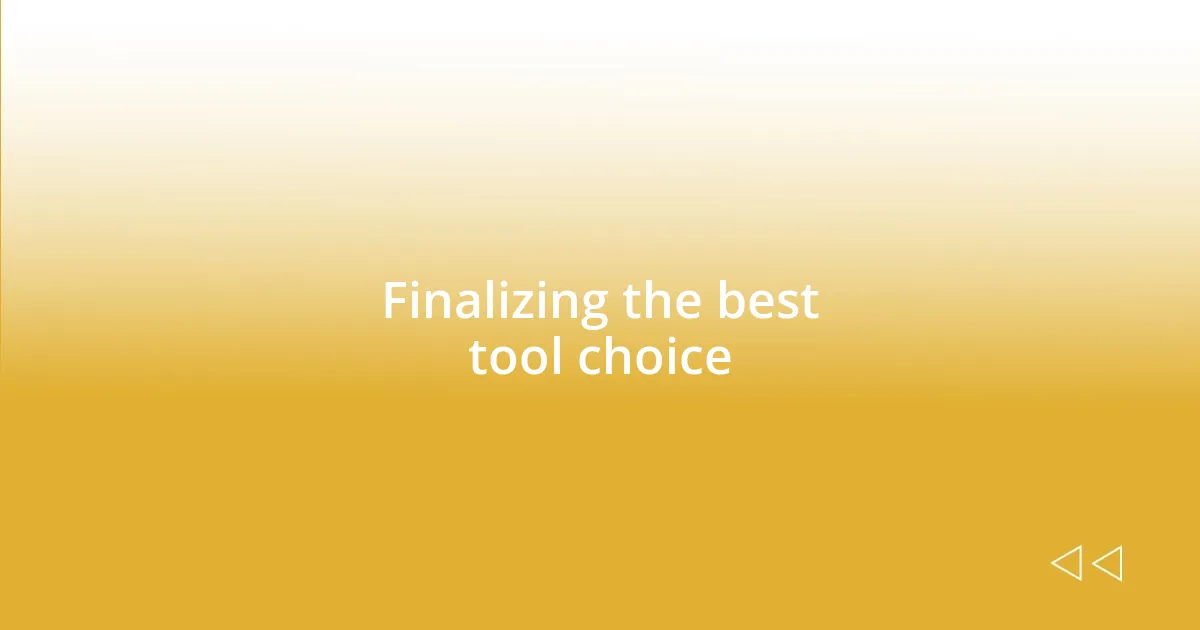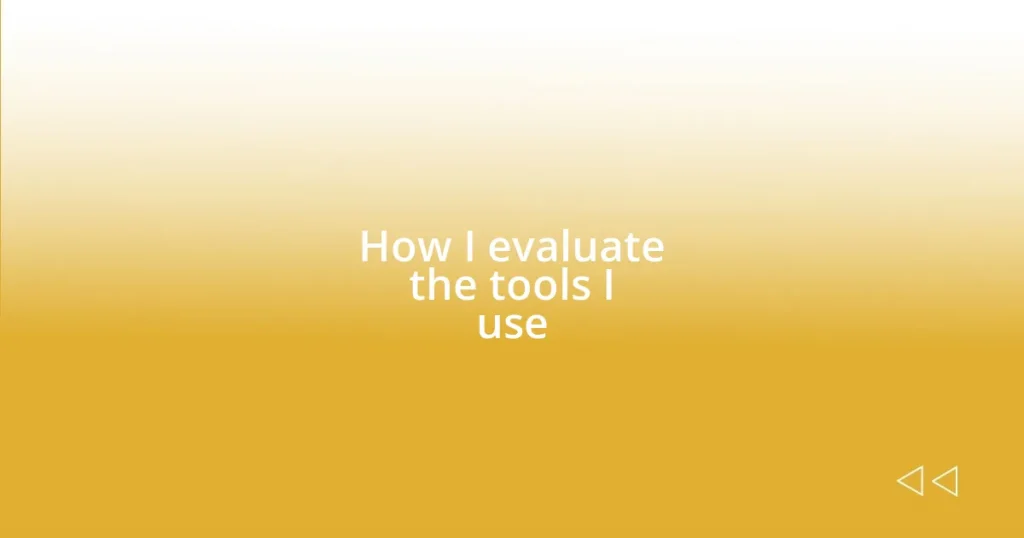Key takeaways:
- Identifying key evaluation criteria such as usability, features, and support is crucial for effective decision-making.
- Hands-on trials provide valuable insights and highlight the importance of responsive customer support in user experience.
- Gathering user feedback, both formally and informally, can uncover usability issues and enhance overall tool effectiveness.
- Finalizing a tool choice involves considering long-term goals and trusting your instincts, combining both research and emotional responses.

Understanding the evaluation process
Understanding the evaluation process is all about bringing clarity to your decision-making. I remember the first time I faced a tough choice between two similar tools; it felt overwhelming. How do you differentiate between options when they seem equally promising?
When I evaluate a tool, I focus on specific criteria such as usability, features, and support. For instance, I once struggled with a software that had great functionality but was cumbersome to navigate. That experience made me realize how crucial a user-friendly interface is; after all, if it’s hard to use, how can it be effective?
In my evaluations, I also consider feedback from peers. I often ask myself, “What have their experiences been?” Gathering insights from others can shed light on aspects I might overlook. It’s fascinating how a simple conversation can lead to a clearer understanding of what to prioritize in my tool selection process.

Identifying key evaluation criteria
Identifying key evaluation criteria is a crucial step in the decision-making process. I’ve learned that it often helps to first outline the essential features that align with my goals. For example, during a recent search for project management software, I found myself jotting down what I truly needed, like collaboration tools and integration capabilities. This personal inventory made it easier to filter out tools that didn’t meet my core requirements, streamlining what could otherwise become an exhausting selection process.
Here are some criteria I usually consider when evaluating a tool:
- Usability: Is the interface intuitive?
- Features: Does it offer the functionalities I need?
- Support: Is customer service readily available and helpful?
- Cost: Does it fit within my budget without compromising on quality?
- Flexibility: Can it adapt to my evolving needs?
By reflecting on these points, I can better understand not just what I want from a tool, but why those factors matter to my workflow. For instance, I once invested in a tool based solely on its flashy features, only to realize later that I had overlooked usability. That lesson taught me to prioritize simplicity over complexity, profoundly shaping my evaluation criteria moving forward.

Researching available tools
When I start researching available tools, I dive into online reviews and forums. It’s enlightening to sift through user experiences, revealing strengths and weaknesses that might not be apparent from just browsing a website. I remember spending hours on a community forum, reading about a specific tool that others found frustrating due to its steep learning curve. That firsthand insight was invaluable; it helped me avoid a costly mistake.
Another aspect I find crucial is comparing features across different tools. I often create a spreadsheet to visualize what each option offers. For example, while researching for a graphic design program, I compared options side by side. Seeing things laid out in a table clarified which tool would serve my purpose best, especially since some programs had overlapping features but differed greatly in cost and usability.
Lastly, I seek recommendations from trusted colleagues or industry experts. Their insights often highlight aspects I hadn’t considered. Just the other week, a friend suggested a tool that didn’t make my initial shortlist. After her enthusiastic endorsement and sharing her own success story, I took the time to explore it. That led me to discover a hidden gem that fits my needs perfectly!
| Tool Name | Usability | Features | Support | Cost |
|---|---|---|---|---|
| Tool A | High | Moderate | Excellent | $50/month |
| Tool B | Moderate | High | Good | $30/month |
| Tool C | Low | High | Average | $20/month |

Comparing tool features and benefits
When I compare tool features and benefits, I always look for that balance between what feels powerful and what feels easy to navigate. A perfect example is when I evaluated two scheduling tools—one was packed with features but felt like a maze, while the other was simple yet effective. I wondered, which tool would make my life easier rather than complicate it? That balancing act is crucial in my decision-making.
I also find it helpful to envision how each tool would fit into my daily workflow. A while back, I was torn between a popular software with great features and a lesser-known option that was far more user-friendly. It dawned on me that I’d rather spend more time focusing on my work than fumbling through complicated setups. This realization reinforced my belief that the best tools aren’t always the most feature-rich, but rather those that integrate seamlessly into the way I work.
While assessing cost against features, I often think about what I’m really getting for my money. For instance, when I came across a tool offering a high price tag with mediocre support, I paused and asked myself: Is the investment truly worth it? That reflective moment prompted me to dig deeper, seeking value not just in features but also in the overall user experience. Sometimes, a more affordable option with excellent support can lead to greater long-term satisfaction, and I’ve learned to prioritize that in my evaluations.

Testing tools through trials
Testing tools through trials is where the rubber meets the road for me. I always find it fascinating to put a tool to the test in real-world scenarios. There was a time when I trialed a project management software that promised to boost team productivity. During the trial period, I discovered that while it offered a plethora of features, its functionalities were clunky and didn’t resonate with my team’s workflow. That experience was eye-opening; it reinforced the idea that no amount of hype can replace hands-on experience.
In my trials, I also pay close attention to the customer support aspects. I still recall the frustration I felt during a trial with a new analytics tool. As I tried to navigate its complex interface, I hit a roadblock. I reached out for assistance, only to face long wait times for a response. That initial interaction told me exactly what I needed to know about the level of support I could expect if I decided to commit. It’s moments like these that truly shape my evaluations; they highlight how critical responsive support is to a smooth user experience.
I sometimes question whether I should trust a tool’s trial period fully. For example, I once tried a popular design tool with an enticing free trial, but it seemed to hold back some of its best features until I committed financially. Did they believe that mixing offerings would entice me to pay? While the limited features frustrated me, it also sparked curiosity about what more it had to offer. Now, I always keep an eye out for clear transparency during trial periods—knowing I’m getting a true feel for the tool rather than a watered-down version is important to me.

Gathering feedback from users
Gathering feedback from users is one of my key strategies in evaluating tools. I recall a time when I launched a new collaboration app for my team. To gauge its effectiveness, I set up a simple survey to collect their opinions and experiences. The results were enlightening; several users pointed out features I hadn’t thought needed improvement, guiding me to make informed adjustments that significantly enhanced our workflows.
I always find it interesting how casual conversations can reveal user sentiments that surveys might miss. Just the other day, I chatted with a colleague about a CRM tool we were both using. Her anecdote about a frustrating data entry process made me realize I wasn’t alone in feeling overwhelmed by certain aspects. By fostering an environment where feedback flows freely, I can identify usability issues and enhancements that might not surface in more structured feedback forms.
Listening to user feedback isn’t just about gathering data; it’s about connecting with their experiences and emotions. I once organized a feedback session where team members could express their thoughts openly. Hearing their frustrations and successes made me appreciate the tool on a deeper level. It highlighted how engaged and invested users could be in shaping a tool’s development. In my experience, when users feel heard, they are more likely to embrace the tool—and that’s a win-win for everyone involved.

Finalizing the best tool choice
Finalizing my tool choice often comes down to integrating all the information I’ve gathered along the way. After trialing various options and compiling user feedback, I create a pros and cons list. I still remember sifting through spreadsheets while deciding on a CRM tool; seeing everything laid out made it so much clearer. Isn’t it incredible how visualizing your thoughts can lead to a breakthrough in decision-making?
I also consider how a tool fits into my long-term goals. Once, I overlooked the scalability of an amazing project management tool because it seemed perfect for my immediate needs. A few months later, I found myself scrambling when my team outgrew its capabilities. It taught me that a tool’s potential for growth is just as crucial as its current features. Do we really want to reinvest in a fresh solution every time we expand?
Finally, I trust my gut feeling at this stage. I remember feeling a mix of excitement and unease when choosing between two similar tools; one felt intuitively right while the other didn’t spark joy. It’s funny how emotions play a role in these decisions. After all, when I’m comfortable with a tool, I’m more inclined to explore its full capabilities. Following that instinct—alongside my research—has made all the difference.















